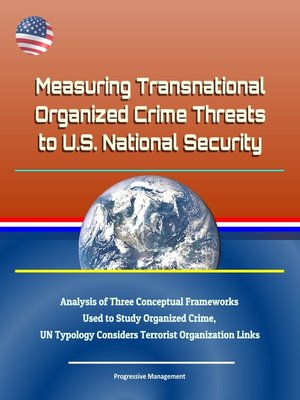Measuring Transnational Organized Crime Threats to U.S. National Security
ebook ∣ Analysis of Three Conceptual Frameworks Used to Study Organized Crime, UN Typology Considers Terrorist Organization Links

Sign up to save your library
With an OverDrive account, you can save your favorite libraries for at-a-glance information about availability. Find out more about OverDrive accounts.
Find this title in Libby, the library reading app by OverDrive.



Search for a digital library with this title
Title found at these libraries:
| Library Name | Distance |
|---|---|
| Loading... |
This report has been professionally converted for accurate flowing-text e-book format reproduction. In 2011 President Obama released the United States Strategy to Combat Transnational Organized Crime (SCTOC). The strategy identified Transnational Organized Crime (TOC) as a national security threat directed the creation of an Interagency Threat Mitigation Working Group (TMWG). The SCTOC tasked the TMWG to identify criminal networks that posed a sufficiently high national security threat to merit a whole-of-government approach to achieve their defeat. Unfortunately, the SCTOC did not include any methodology for differentiating between criminal networks. Organized crime typologies, models, and assessment tools do exist. However, not all these tools are necessarily suitable for the TMWG. The question was, therefore, is there an existing typology or assessment model that can identify the TOC groups that present the national security threat defined in the SCTOC?
A literature review of existing organized crime assessments identified the three most common conceptual frameworks used to study organized crime. These frameworks are organization-based, activities-based, and harm-based. The SCTOC discussion of TOC most closely resembles an organization-based conceptual framework. Therefore, all activities-based, and harm-based typologies were ruled out. SCTOC also identified specific selection criteria that helped match the SCTOC with an appropriate organization-based typology. The most appropriate model must be simple, support UN common terms, include key SCTOC variables, and address links to terrorists. A number of organization-based typologies were analyzed.
The research found that The United Nations report, "Pilot Survey of Forty Selected Organized Criminal Groups in Sixteen Countries" meets the needs of the Threat Mitigation Working Group (TMWG) best. The UN typology is not designed to score TOC networks, so it is not an obvious choice, but it could be easily modified by the TMWG to rank-order TOC networks. The UN typology has the advantage of following the same conceptual model followed by the SCTOC. It is one of the few assessment tools to consider criminal links to terrorist organizations directly. It is also relatively simple, with clear definitions of all the relevant variables.
Contents: 1. Introduction 2. TOC and U.S. National Security 3. Conceptual Frameworks for Describing and Measuring Transnational Organized Crime 4. The United States Strategy to Combat Transnational Organized Crime 5. Assessment and Comparison of Selected TOC Typologies 6. Conclusion
Unfortunately, despite international agreement that organized crime is a threat to national and global interests, global cooperation is hampered by the fact that there is very little agreement on how to define or measure transnational organized crime. Even the United Nations Office on Drugs and Crime (UNODC) failed to achieve consensus on either a definition for organized crime or the types of crime that constitute that phenomenon. Similarly, the European Union attempt to define organized crime was a failure. Academics around the world complain that "behind this international political consensus on the importance and the threat of organized crime there is, nevertheless, a large and gaping scientific void." Despite all analysis available on TOC, no studies provide meaningful explanations for the seriousness and threat of organized crime, or a sound basis for the measurement of organized crime. The lack of a widely accepted definition impacts coordination between nations and between agencies within the United States government. Without a common definition it is impossible to agree upon methods by which...







